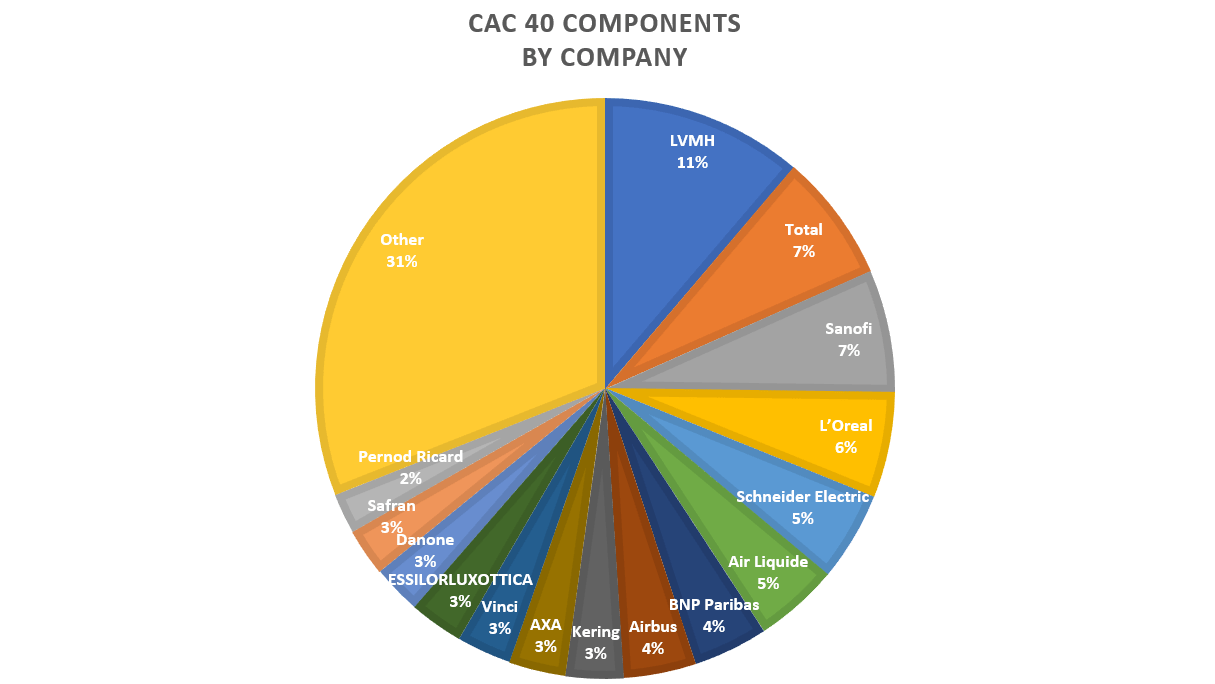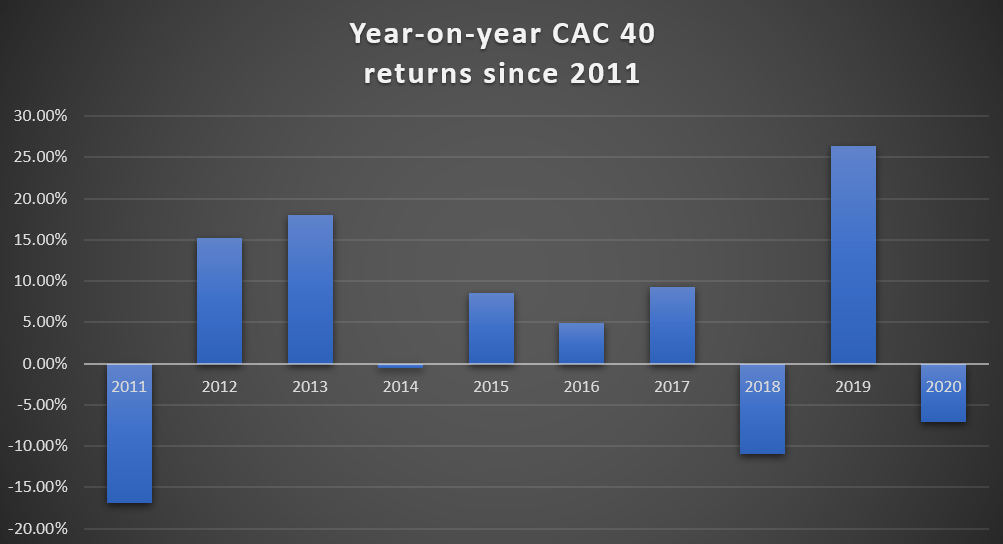CAC 40 trading guide: constituents, market hours and how to trade
- What is the CAC 40?
- About CAC 40 constituents
- How often do CAC 40 companies change?
- How is the CAC 40 calculated?
- What does the CAC 40 price mean?
- What affects the CAC 40 price?
- Average annual returns of the CAC 40
- CAC 40 market hours
- How to trade the CAC40
- How to short the CAC 40
- Can you invest in the CAC 40 in the UK?
- CAC 40 companies ranked by market capitalisation
What is the CAC40?
The CAC 40 is a stock index that tracks the performance of the 40 largest stocks listed on the wider Euronext Paris, France’s largest stock exchange. The CAC 40, which stands for Cotation Assistée en Continu, is seen as a key benchmark for the French economy and attracts interest from traders around Europe and the world.
Launched in 1987 with a value set at 1,000, the CAC 40 is a market capitalisation weighted index, meaning that, like the German Dax or the FTSE 100, the most capitalised companies in the index are given a greater weighting.
About CAC40 constituents
The largest constituents of the index by weighting feature the likes of oil giant Total, banking operator BNP Paribas and luxury goods conglomerate LVMH (Louis Vuitton). Here’s how the CAC 40 sector composition looked as of June 10 2021.

How often do CAC 40 companies change?
CAC 40 companies can potentially change every quarter when the composition is reviewed by an independent steering committee. The purpose of this review is to ensure the weighting and index selection accurately reflects the underlying market. A more recent addition to the index is French multinational rolling stock manufacturer Alstom, which was listed in September 2020.
How is the CAC 40 calculated?
The CAC 40 is calculated on a price return basis. The calculation is based on the current numbers of shares included in the index of each constituent multiplied by the last closing price and subsequently divided by an index divisor. The divisor itself, which is adapted based on composition changes, is calculated based on the initial capitalisation base of the index and the base level.
What does the CAC 40 price mean?
The price of the CAC 40 indicates whether the share prices of the companies on the index are rising or falling. If the price of the CAC 40 is increasing, it means that a specific company or group of companies are experiencing gains, which is reflected in the price of the overall index. Conversely, if the CAC 40 price is falling, it means that companies on the index are experiencing a decline in price.
The CAC 40 ranking is based on a weighted average of share prices. This means companies with a larger weighting will often see their share price fluctuations have a correspondingly outsized impact on the wider index.
What affects the CAC 40 price?
The CAC 40 price is affected by a variety of fundamental and technical drivers linked to the behaviour of the French and European economy, as well as international influences. European Central Bank monetary policy can have a notable impact, as does foreign exchange rates, economic data releases, and even commodity prices.
While such drivers may be expected to move the index in a certain direction, there is no guarantee that the move will play out, so traders should consider how determining factors work together rather than simply isolate any one factor. That said, here are a few of the key things to consider when trading the CAC 40.
Monetary policy and economic releasesWhen European Central Bank monetary policy is accommodative, interest rates tend to fall and the general money supply and credit opportunities increase. This means corporate debt becomes more attractive to obtain and cheaper to service, creating potential for business growth and often boosting stock prices in turn.
Additionally, economic data releases can have a large influence on trading decisions. Inflation is one measure that can hit stock indices as it can erode profit margins across sectors and also is seen as a potential forebear of longer-term higher interest rates. For example, in May 2021 inflation fears prompted the price of such CAC 40 leaders as LVMH and L’Oreal to cause a drop in the wider index of some 1.3% in a day.
Individual company performanceAs mentioned, companies that are weighted the highest in the index are more capable of moving the index than smaller constituents. For example, Total is considerably more capable of causing changes in the CAC 40 price than Renault.
Socio-political events
Events such as the Great Recession and the coronavirus pandemic are all capable of hitting market demand in one way or another. For example, the pandemic in 2020 caused a sharp deterioration in manufacturing activity and market demand, seeing the CAC 40 plummet 40% in March 2020 from its record high in February that year.
Average annual returns of the CAC 40
Over the last ten years, the CAC 40 has produced an average annual return of 4.6%. The CAC 40 average returns are essentially what managed funds will have earned in profit for investors over the course of a year.
You can see the yearly returns from 2011-2020 below. Remember, past returns are no guarantee of future performance.

CAC 40 market hours
The main trading hours for the CAC 40 are between 09:00 – 17:30 (CET).
Read more on stock market hours.
How to trade the CAC 40
There are a number of ways that you can trade the CAC 40; the most common are derivatives such as CFDs, futures and options, as well as ETFs. All of these instruments enable you to get exposure to all 50 companies from a single position.
CAC 40 CFDs
Contracts for difference (CFDs) are derivatives that take their price from the underlying market, in this case the CAC 40. As you’ll never be taking ownership of an asset, you can speculate on whether the index is going to rise or fall in value.
Learn more about CFDs.
CAC 40 futures
Futures contracts are agreements to exchange an asset at a set price on a set expiry date. Unlike most futures, CAC 40 contracts don’t have an underlying physical asset to exchange, as an index is nothing more than a number representing a group of stocks.
CAC 40 options
CAC 40 options are contracts that give you the right, but not the obligation, to buy or sell the index at a set price on a set date.
As and when CAC 40 options are available to trade, you'd be doing so via CFDs.
CAC 40 stocks and ETFs
You can also trade the CAC 40 through ETFs, or investment instruments that hold a group of stocks – in this case, the shares of constituents on the index.
Alternatively, stocks on the CAC 40 can naturally be traded individually, offering an opportunity to focus on particular sectors of interest.
Find out more about share trading with us.
How to short the CAC 40
Shorting the CAC 40 involves taking a position that the index will fall. This can be done by selling short a CAC 40 contract or shorting constituent stocks. Alternatively, traders may be interested in shorting a CAC 40 ETF. For options, you can buy Put options on CAC 40 stocks if you believe them to be overvalued, or buy a Put option on a CAC 40 ETF.
Read more about shorting a market.
Can you invest in the CAC 40 in the UK?
You can invest in the CAC 40 in the UK, albeit indirectly, through a combination of ETF, mutual funds or index funds, or of course trade the security through derivatives in the methods outlined above.
CAC 40 companies ranked by market capitalisation
The below chart shows the 40 companies in the CAC 40, correct as of June 2021. At the point captured, the top ten alone made up 55% of the weighting for the entire index, illustrating the influence these companies can have on the whole benchmark.
|
Rank |
Ticker |
Company name |
Weighting |
|
1 |
MC.PA |
LVMH |
11.25% |
|
2 |
FP.PA |
Total |
7.15% |
|
3 |
SAN.PA |
Sanofi |
6.81% |
|
4 |
OR.PA |
L’Oreal |
5.87% |
|
5 |
SU.PA |
Schneider Electric |
5% |
|
6 |
AI.PA |
Air Liquide |
4.7% |
|
BNP.PA |
BNP Paribas |
4.16% |
|
|
8 |
AIR.PA |
Airbus |
4.05% |
|
9 |
KER.PA |
Kering |
3.18% |
|
10 |
CS.PA |
AXA |
3.16% |
|
11 |
DG.PA |
Vinci |
3.05% |
|
12 |
EL.PA |
ESSILORLUXOTTICA |
3.03% |
|
13 |
BN.PA |
Danone |
2.72% |
|
14 |
SAF.PA |
Safran |
2.65% |
|
15 |
RI.PA |
Pernod Ricard |
2.24% |
|
16 |
STLA.PA |
Stellantis |
2.18% |
|
17 |
RMS.PA |
Hermes |
2.13% |
|
18 |
VIV.PA |
Vivendi |
1.78% |
|
19 |
SGO.PA |
Saint-Gobain |
1.76% |
|
20 |
DSY.PA |
Dassault Systemes |
1.72% |
|
21 |
CAP.PA |
Capgemini |
1.67% |
|
22 |
ML.PA |
Michelin |
1.63% |
|
23 |
ENGI.PA |
Engie |
1.58% |
|
24 |
LR.PA |
Legrand |
1.51% |
|
25 |
STM.PA |
STMicroelectronics |
1.48% |
|
26 |
ORA.PA |
Orange |
1.40% |
|
27 |
TEP.PA |
Teleperformance |
1.30% |
|
28 |
GLE.PA |
Société Générale |
1.29% |
|
29 |
MT.PA |
ArcelorMittal |
1.26% |
|
30 |
WLN.PA |
Worldline |
1.23% |
|
31 |
ACA.PA |
Crédit Agricole |
1.02% |
|
32 |
ALO.PA |
Alstom |
0.84% |
|
33 |
VIE.PA |
Veolia Environ |
0.84% |
|
34 |
PUB.PA |
Publicis Groupe |
0.80% |
|
35 |
CA.PA |
Carrefour |
0.68% |
|
36 |
URW.PA |
Unibail |
0.67% |
|
37 |
HO.PA |
Thales |
0.64% |
|
38 |
EN.PA |
Bouygues |
0.56% |
|
39 |
RNO.PA |
Renault |
0.55% |
|
40 |
ATO.PA |
ATOS |
0.47% |



